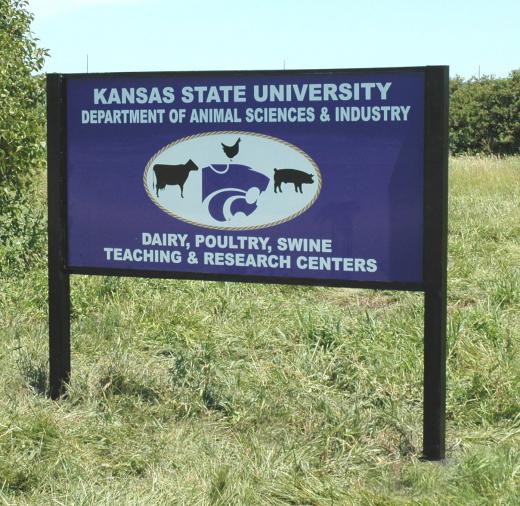Poultry Unit

Description
The Tom Avery Poultry Research Farm is located at 2000 Marlatt Avenue. The original facility was constructed in 1966 and updates have occurred frequently in recent years. The farm conducts teaching, research and extension related projects. Farm stock include broilers, layers, and turkeys. The farm processes eggs produced by the layer flock which are then sold in the KSU Dairy Plant.
Research projects focus on feed manufacturing for meat birds, heritage poultry, and general nutrition. The farm supports ASI projects related to the nutrition of other species such as beef and swine. Many studies are conducted in support of other campus Departments such as Grain Science and Industry, where students in the feed industry are able to conduct projects related to poultry. Tours are often available, but only by appointment.
The poultry farm maintains an egg producing flock for teaching and research purposes. The excess eggs are currently marketed to a local egg processor or are sold to retail markets. The farm has incubator space for 10,000 eggs. We generally do not conduct any processing of meat-type birds because of the small scale of our facilities, however, we often process birds for experiments to determine things like percent yield, carcass fat, etc.
The Poultry and Game Bird Unit is not a 'farm' in the strict definition since it is used for research purposes. This is why you won't see large commercial type buildings with open spaces. Because the poultry industry utilizes different management practices, you will see many different types of cages, floor pens, and environmental controls. The cages and pens are divided into smaller units for statistical purposes and for things like providing different diets to groups of hens.
Building 1 This building is for teaching purposes. It maintains stock for demonstrations, 4H and FFA events, and for classes like poultry management and the KSU Poultry Judging Team.
Building 2 This building is set up with floor pens to conduct studies with breeding stock.
Building 3 This building is currently being updated to conduct research on heritage breeds, and free-range poultry. The interior of the building is being remodeled using only minimal technology, with natural ventilation and minimal cost, but with keeping animal comfort in mind. There are outdoor pens to allow the birds access to dirt and grass. Few universities have facilities which may conduct free range studies using poultry. The studies focus on turf management, nutrition of free range birds, genetics, and husbandry techniques.
Building 4 This unit is currently being remodeled and updated for general poultry research. A computer controlled whole-house management system will enable students to learn the proper husbandry of all types of meat-type poultry. They will then be able to manipulate the environment and study the effects of changes on bird growth.
Building 5 The north end of this house is used for commercial broiler research and was updated in 1997. Why on Earth does KSU need to conduct broiler research when few are grown commercially in Kansas? Mostly, the facility is used to test feed manufacturing processes on growth and conformation. KSU currently has the only Feed Manufacturing program in the US and a lot of Kansas grain is used by the poultry industry. Many graduates are hired by the poultry industry to operate these large-scale feed mills. The feed mixing and storage room is for mixing small research diets. Most diets are small today because of expense and a large mill would not adequately mix the small amounts. Battery brooders are available which are used to conduct nutritional research during the crucial early growth phase. Almost all nutrition research organizations utilize these brooders to grow chicks used for nutrition research. Chicks are used because of their rapid growth and reduced cost to purchase and grow them. Many grain companies use chicks to test the value of new varieties of grain. This house also includes an environmentally controlled caged layer room. Again, it is not automated so that research studies can be conducted. It is light controlled.
Building 6 This building was recently remodeled during the summer, 1994. The south end of this house is used for conducting broiler feeding trials and game bird research. Since broilers cannot fly but most game birds can, the sides of the large pens are built to the ceiling. Game birds are not domesticated and fly very well. And since most game birds are grown for release, they need some space to allow for exercising their flight muscles. The north end of this house is used for pullet grow out. Pullets are generally started in a "grow out" cage system, then transferred to egg production cages around 18 weeks of age. Most pullets are fed by an automated system, but for the purposes of research, this has been removed.
Building 7 This facility is the shop, and is used for equipment storage.
Building 8 This is the main office for the poultry farm. Visitors and tours must check in here before proceeding to the farm buildings. The office has the hatchery, an egg processing machine, and processing equipment. For more information about the poultry farm, you may contact them at 539-5041.
Poultry Unit
2000 Marlatt Avenue
Manhattan, 66506
Contact Information
Scott Beyer
Associate Professor
Farm Manager
785-532-1201
sbeyer@k-state.edu
785-532-5654